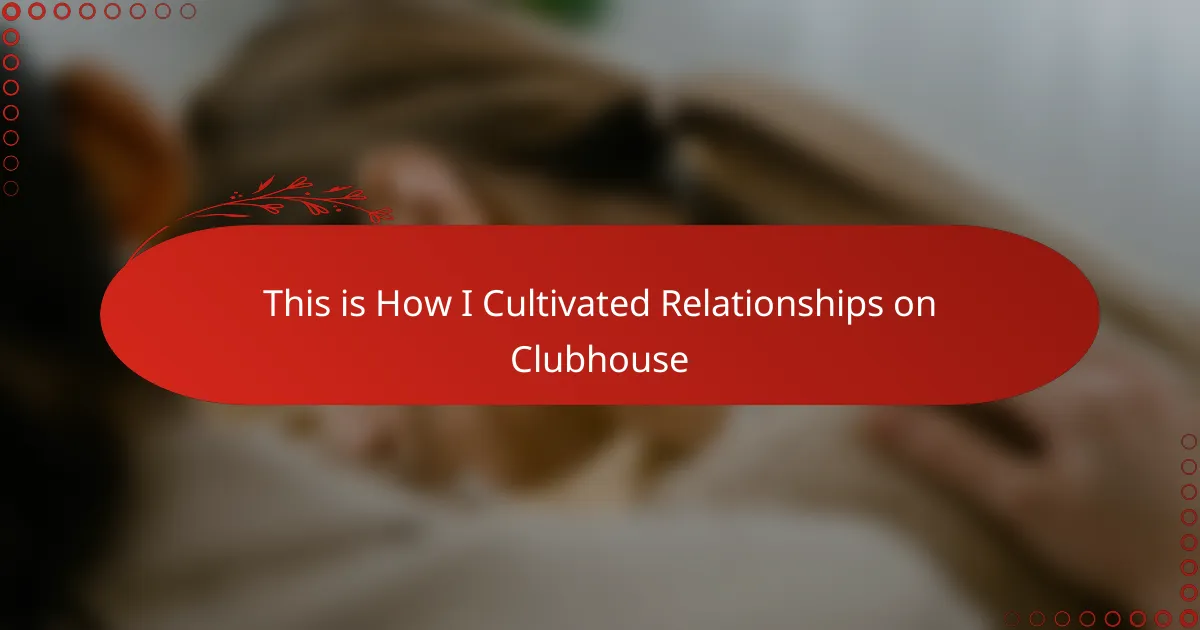Key takeaways
- Clubhouse acts as a modern extension of radio, fostering active participation and genuine connections through live audio interactions.
- Creating an engaging profile is essential for attracting like-minded individuals and establishing trust, similar to setting the tone of a radio show.
- Building relationships on Clubhouse requires consistency, vulnerability, and genuine engagement, reminiscent of nurturing a loyal radio audience.
- Sharing personal stories and experiences enhances connections, inviting deeper conversations and creating memorable exchanges among participants.
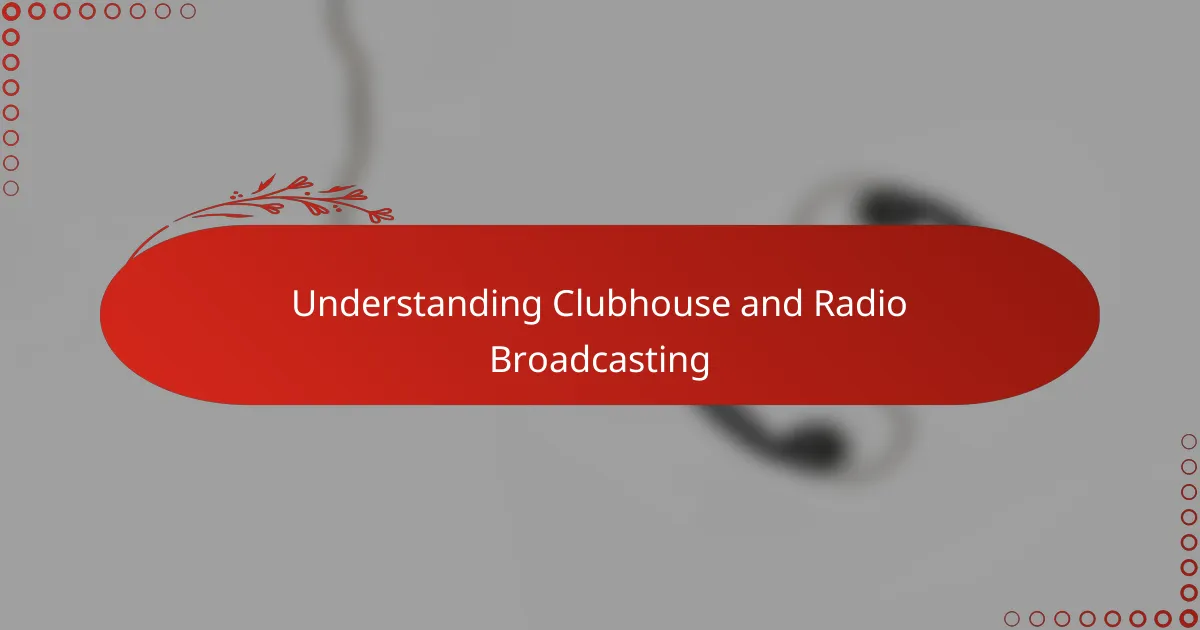
Understanding Clubhouse and Radio Broadcasting
Clubhouse feels like a natural extension of radio broadcasting to me, blending live audio chats with real-time interaction. I often find myself wondering how traditional radio hosts who mastered the art of voice might adapt to this new platform—after all, both rely so heavily on the power of voice to connect.
What fascinates me about Clubhouse is how it democratizes the radio experience; anyone can become a host, creating a spontaneous community conversation. I remember my first experience on Clubhouse, where the energy of a live audience responding instantly reminded me of the vibrant connection I’ve always loved about radio shows.
Yet, unlike traditional radio, Clubhouse breaks down the barrier between speakers and listeners, turning passive audiences into active participants. This shift has deepened my appreciation for radio as a medium that thrives on real-time engagement, making me rethink what it means to cultivate authentic relationships through sound alone.

Setting Up Your Clubhouse Profile
Creating my Clubhouse profile felt like setting the stage for a radio show—except this time, I was both the host and the first guest. Choosing the right profile picture was my first step; I wanted it to feel approachable and genuine, like the kind of voice listeners trust when tuning into a late-night broadcast. Have you ever wondered what your profile says about you before you even speak? That thought guided me in crafting a bio that was both clear and inviting, highlighting my passion for radio and live audio.
I kept my bio short but impactful, knowing that listeners on Clubhouse decide quickly whether to stay in a room or move on. I included keywords related to radio broadcasting to attract like-minded people, because, honestly, finding the right crowd is everything. The little detail of linking my Instagram helped build an extra layer of trust—people could see there’s more to me than just a username and a voice.
What surprised me most was how these small choices in setting up my profile led to immediate connections. It’s like preparing a radio show’s intro—getting the tone right makes all the difference in who tunes in and how they engage. I realized that a well-thought-out profile isn’t just a digital resume; it’s the first real conversation you have with your audience.
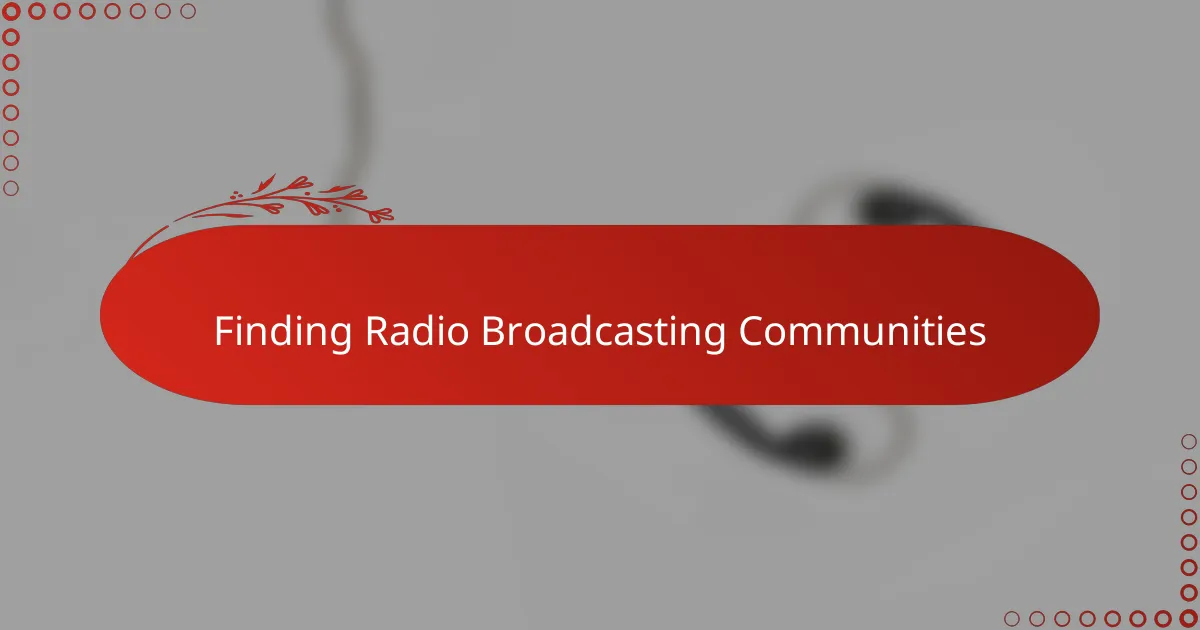
Finding Radio Broadcasting Communities
Finding radio broadcasting communities on Clubhouse felt like tuning into a hidden frequency at first. I remember scrolling through countless rooms before stumbling upon a vibrant group of hosts and enthusiasts who shared my love for live audio. It made me ask myself: where else could I connect with people who truly understand the nuances of radio broadcasting?
What struck me was how these communities were not just about sharing technical tips, but also exchanging stories, experiences, and passion for the craft. It reminded me of those late-night radio talk shows where listeners become part of the conversation, creating a sense of belonging that I hadn’t expected to find in a social app. Have you ever felt that instant connection with strangers just because of a shared passion? That’s exactly what happened to me here.
Joining these groups wasn’t just a matter of clicking “join room”; it was about showing up consistently, listening actively, and occasionally raising my hand to speak. Over time, I noticed familiar voices and friendly welcomes, like being part of a radio family. The real magic, I think, comes from that mix of authenticity and shared enthusiasm—something every radio broadcaster knows is essential to building lasting relationships.
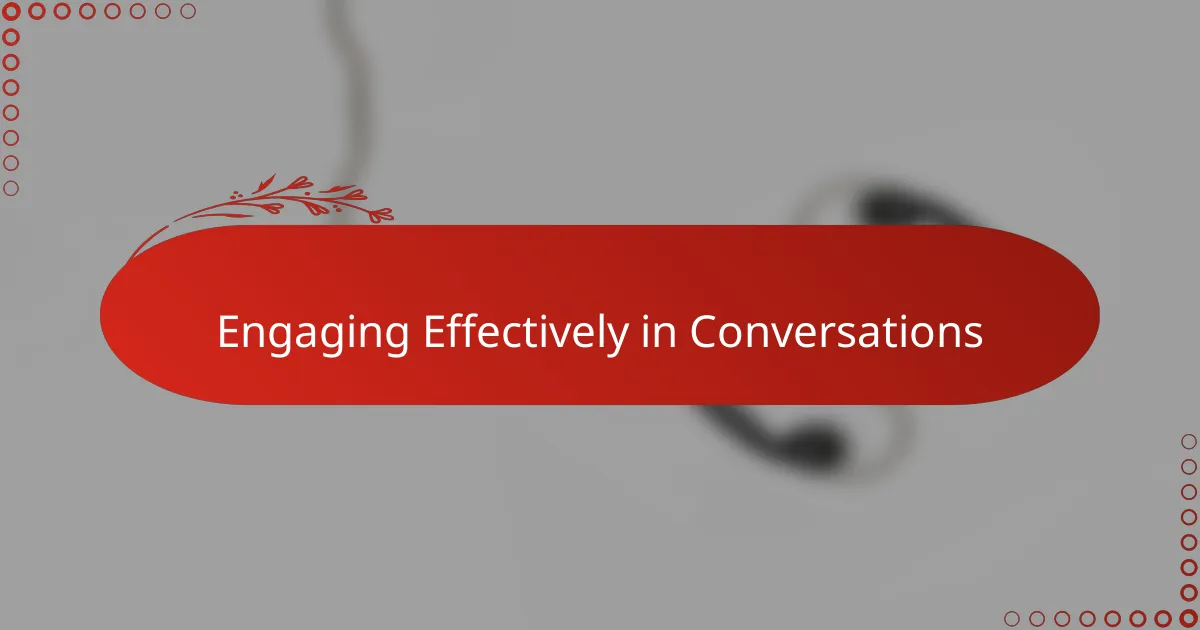
Engaging Effectively in Conversations
Engaging effectively in conversations on Clubhouse reminded me a lot of hosting a live radio segment where timing and tone shape the entire experience. I learned that jumping in too soon can disrupt the flow, but waiting too long might mean missing the moment to add something valuable. Have you ever felt that delicate balance between speaking up and listening? It’s a skill I honed by observing others and patiently finding my place in the rhythm.
One thing I quickly noticed was how asking thoughtful questions opened doors to deeper discussions. Instead of just sharing my ideas, I started inviting others to elaborate, which made the conversations feel more like meaningful exchanges rather than one-way broadcasts. It created a sense of connection that I cherish—almost like inviting someone into your studio and letting them take part in the show.
Sometimes, I’d share a quick story or personal insight to break the ice, especially when the room felt a bit formal or stiff. Those moments of vulnerability made me feel more authentic, and surprisingly, people responded warmly, as if tuning in to a genuine radio voice rather than a scripted host. It made me wonder: isn’t that what real connection is all about—being both professional and personable?
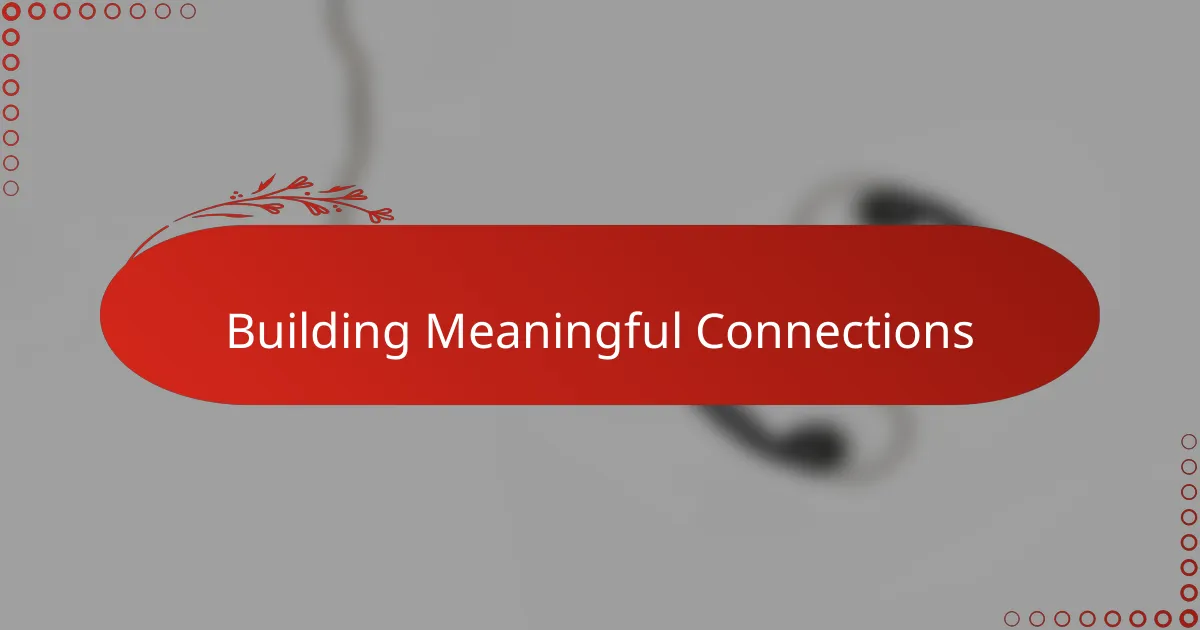
Building Meaningful Connections
Building meaningful connections on Clubhouse felt like discovering a secret signal in the static—one that required patience and genuine interest to catch. I realized early on that it wasn’t about how many people followed me, but about engaging deeply with those few who shared a true passion for radio and live audio. Have you ever noticed how the most powerful conversations often happen when you least expect them, in moments of sincere listening?
What struck me most was how vulnerability paved the way for trust. When I dared to share a personal story or admit what I didn’t know, the room’s energy shifted—it went from distant chatter to intimate dialogue. It reminded me of the rare magic in radio when a host lowers their guard and invites listeners into their world, creating a connection that’s more than just soundwaves.
I found that consistency was key to nurturing these bonds. Showing up regularly, remembering voices and names, and following up after rooms made relationships grow beyond a single conversation. Isn’t it fascinating how building connections on Clubhouse mirrors cultivating a loyal radio audience—both thrive on ongoing, authentic engagement?
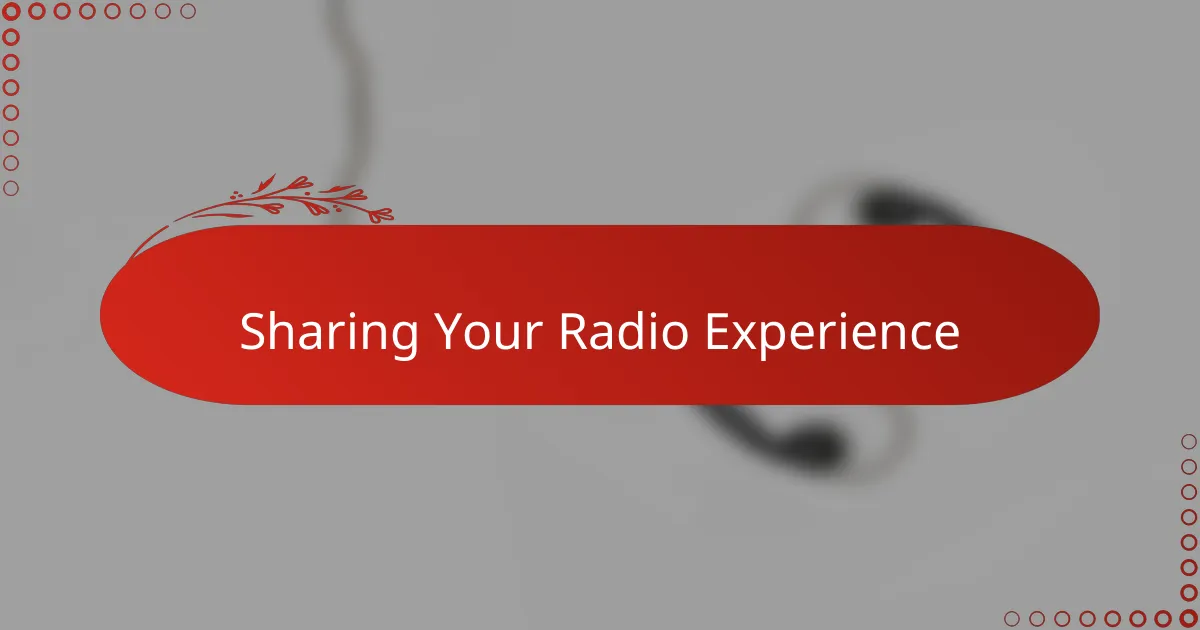
Sharing Your Radio Experience
Sharing my radio experience on Clubhouse felt like opening the mic to a new kind of audience—one that hears not just my voice but also my passion for the craft. I often found myself recounting behind-the-scenes moments from my shows, which sparked curiosity and led to lively discussions. Have you ever noticed how telling stories from your own radio journey invites others to share their experiences too? It’s a unique way to build instant rapport.
Sometimes, I’d describe technical challenges I’d faced during live broadcasts, like battling unexpected feedback or timing cues, and people on Clubhouse would nod in understanding or offer tips. This exchange reminded me that radio isn’t just about smooth delivery; it’s about the shared vulnerability of live performance. Those candid moments created a sense of camaraderie that felt rare and refreshing in a digital space.
One time, I shared a story about connecting with a guest who changed the direction of my show unexpectedly, and the room instantly lit up with similar anecdotes from others. That’s when I realized sharing isn’t just about talking—it’s about creating a memorable experience that resonates with everyone listening, much like a great radio segment that stays with you long after the broadcast ends.
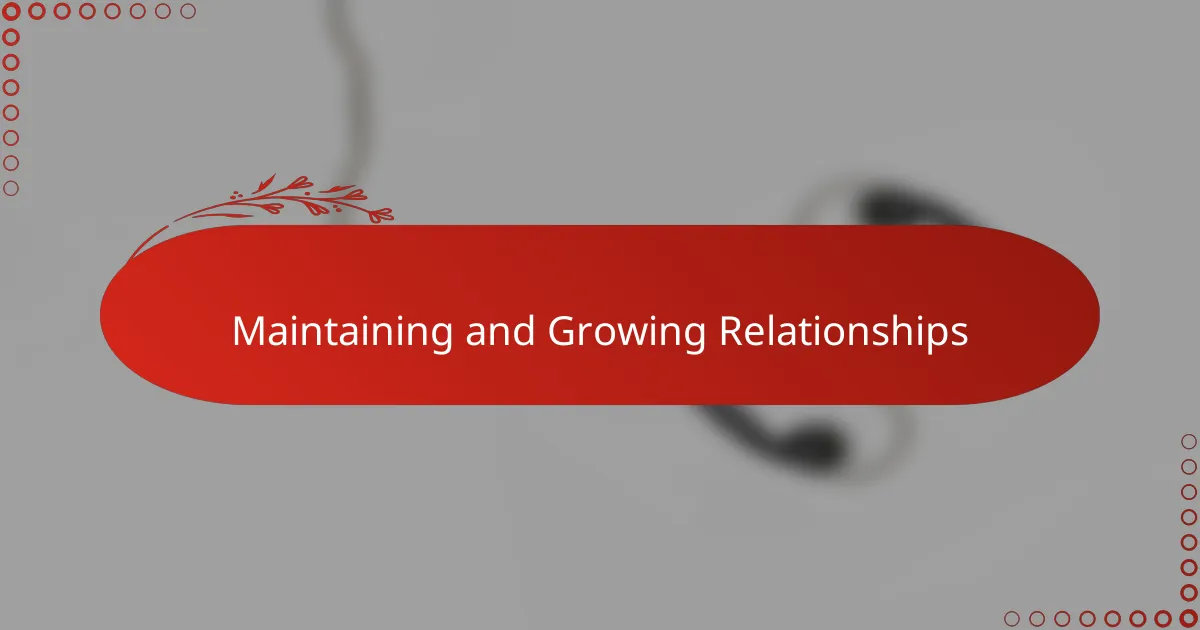
Maintaining and Growing Relationships
Maintaining relationships on Clubhouse, to me, hinges on showing up consistently—just like a beloved radio program that listeners rely on every week. I found that regularly joining rooms and engaging with familiar voices made our connections feel alive, almost like tuning into a favorite radio station where the hosts remember you by name. Have you ever experienced that comforting feeling of being recognized in a crowd? That’s exactly the warmth I sought to recreate online.
Growing these relationships, however, required more than just presence; it meant investing time in genuine conversations. I made it a habit to follow up after meaningful chats, sending messages or reconnecting in subsequent rooms, which deepened our bond far beyond a single interaction. It reminded me of how radio hosts often build loyal listeners by creating a sense of ongoing community—something that can’t be rushed but grows with care.
I also noticed that vulnerability played a crucial role. Sharing both successes and challenges from my radio journey invited others to open up too, turning casual acquaintances into trusted peers. Isn’t it fascinating how authenticity breaks down walls faster than polished conversations? Clubhouse gave me a space to be real, and that honesty became the foundation for lasting relationships.
